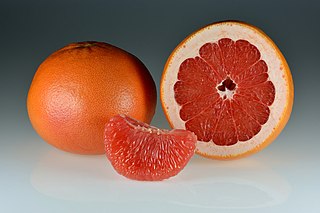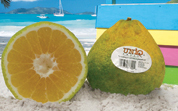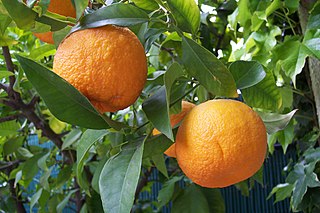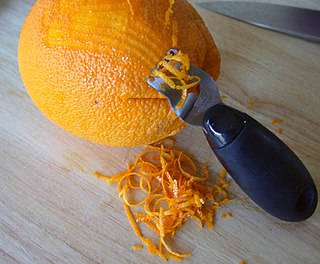
Kumquats, or cumquats in Australian English, are a group of small, angiosperm, fruit-bearing trees in the family Rutaceae. Their taxonomy is disputed. They were previously classified as forming the now-historical genus Fortunella or placed within Citrus, sensu lato. Different classifications have alternatively assigned them to anywhere from a single species, Citrus japonica, to numerous species representing each cultivar. Recent genomic analysis defines three pure species, Citrus hindsii, C. margarita and C. crassifolia, with C. × japonica being a hybrid of the last two.

Citrus is a genus of flowering trees and shrubs in the family Rutaceae. Plants in the genus produce citrus fruits, including important crops such as oranges, mandarins, lemons, grapefruits, pomelos, and limes.

The grapefruit is a subtropical citrus tree known for its relatively large, sour to semi-sweet, somewhat bitter fruit. The interior flesh is segmented and varies in color from pale yellow to dark pink/red.

A mandarin orange, also known as mandarin or mandarine, is a small, rounded citrus tree fruit. Treated as a distinct species of orange, it is usually eaten plain or in fruit salads. Tangerines are a group of orange-colored citrus fruit consisting of hybrids of mandarin orange with some pomelo contribution.

The Jamaican tangelo, also known by proprietary names uglifruit, uglifruit, and uniq fruit, is a citrus fruit that arose on the island of Jamaica through the natural hybridization of a tangerine or orange with a grapefruit, and is thus a tangelo. The original tree is believed to have been a hybrid formed from varieties of Seville orange, grapefruit and tangerine.

The citron, historically cedrate, is a large fragrant citrus fruit with a thick rind. It is said to resemble a 'huge, rough lemon'. It is one of the original citrus fruits from which all other citrus types developed through natural hybrid speciation or artificial hybridization. Though citron cultivars take on a wide variety of physical forms, they are all closely related genetically. It is used in Asian and Mediterranean cuisine, traditional medicines, perfume, and religious rituals and offerings. Hybrids of citrons with other citrus are commercially more prominent, notably lemons and many limes.

Bitter orange, sour orange, Seville orange, bigarade orange, or marmalade orange is in a narrow sense the citrus tree Citrus × aurantium and its fruit. It is native to Southeast Asia and has been spread by humans to many parts of the world. It is probably a cross between the pomelo, Citrus maxima, and the mandarin orange, Citrus reticulata.

The tangelo, Citrus × tangelo, is a citrus fruit hybrid of a Citrus reticulata variety, such as mandarin orange or tangerine, and a Citrus maxima variety, such as a pomelo or grapefruit. The name is a portmanteau of 'tangerine' and 'pomelo'.

The pomelo, also known as a shaddock and from the family Rutaceae, is the largest citrus fruit, and the principal ancestor of the grapefruit. It is a natural, non-hybrid, citrus fruit, native to Southeast Asia. Similar in taste to a sweet grapefruit, the pomelo is commonly consumed and used for festive occasions throughout Southeast Asia and East Asia. As with the grapefruit, phytochemicals in the pomelo have the potential for drug interactions.

Zest is a food ingredient that is prepared by scraping or cutting from the rind of unwaxed citrus fruits such as lemon, orange, citron, and lime. Zest is used to add flavor to many different types of food.

The orange, also called sweet orange to distinguish it from the bitter orange, is the fruit of a tree in the family Rutaceae. Botanically, this is the hybrid Citrus × sinensis, between the pomelo and the mandarin orange. The chloroplast genome, and therefore the maternal line, is that of pomelo. There are many related hybrids including of mandarins and sweet orange. The sweet orange has had its full genome sequenced.

The lemon is a species of small evergreen tree in the flowering plant family Rutaceae, native to Asia, primarily Northeast India (Assam), Northern Myanmar, and China.
A mandelo is a citrus fruit that is smaller than a grapefruit, has yellow or yellow-green coloured skin and bright yellow or yellow-orange flesh, but is sweeter than a grapefruit.
James W. Cameron was an emeritus professor of horticultural science, a geneticist and citrus breeder in the University of California Citrus Experiment Station.

The Melogold or Melogold grapefruit is a citrus hybrid similar to the oroblanco; both result from a cross between the pomelo and the grapefruit and is a fruit similar to a sweet grapefruit.

Citrus taxonomy refers to the botanical classification of the species, varieties, cultivars, and graft hybrids within the genus Citrus and related genera, found in cultivation and in the wild.

Citrus × deliciosa is a citrus hybrid mandarin orange with just under 6 % pomelo ancestry. It is related to the ponkan.

The New Zealand grapefruit, also known as the Poorman, Poorman orange, poorman's orange, poor man's orange, and goldfruit, is a type of citrus fruit grown in New Zealand. Despite its name, it is not genetically a true grapefruit, but rather is believed to be a hybrid between a pomelo and a mandarin or tangelo.
The forbidden fruit is a variety of citrus fruit native to Saint Lucia and once thought to be the origin of the grapefruit.
Kinkoji unshiu is a Citrus hybrid cultivated for its edible fruit.


















